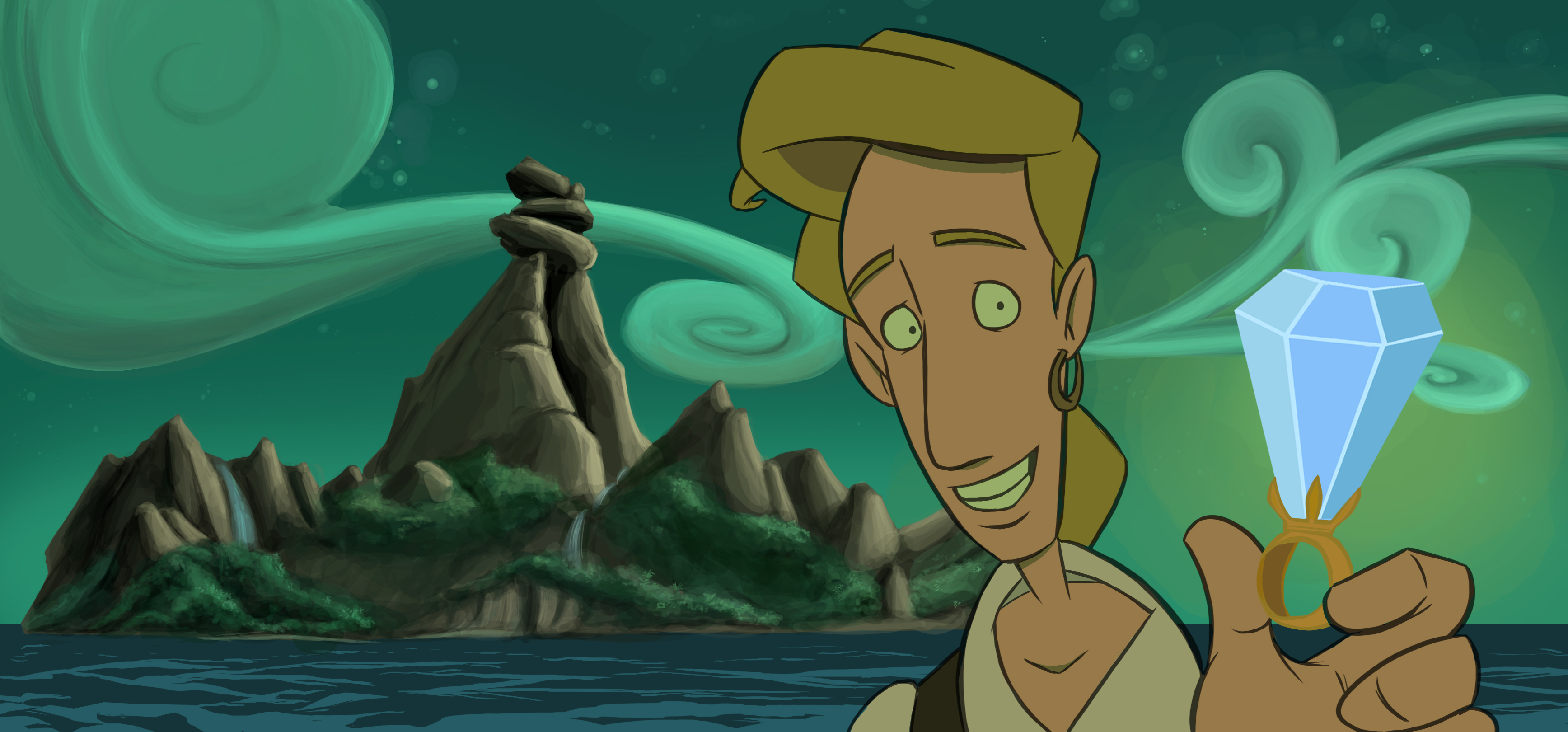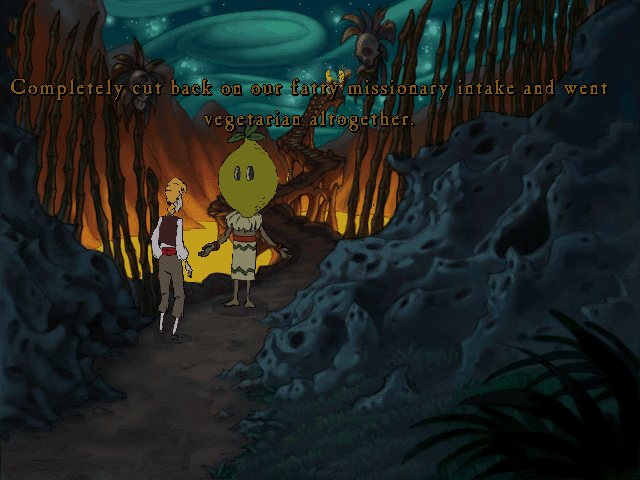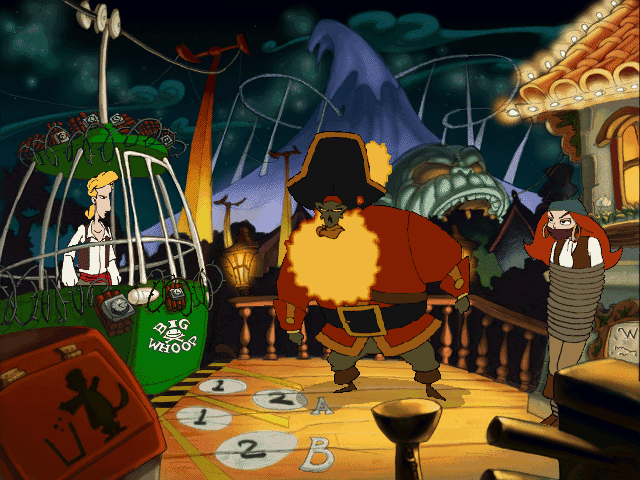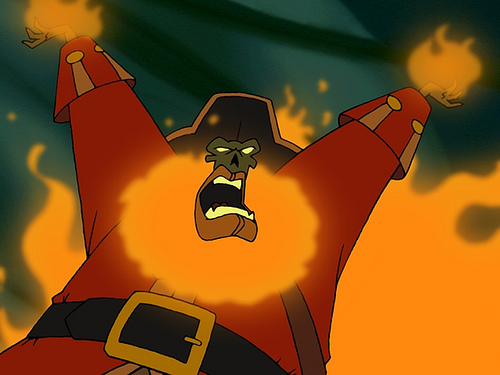Articles

LucasArts' Secret History #12: The Curse of Monkey Island Our Review
After LeChuck's Revenge, it seemed like the Monkey Island series might had completed its run. It wasn't that the second installment wasn't profitable or well-received (its success eclipsed that of the original game) or that there wasn't a story left to be told (if nothing else than to explain a certain bizarre ending), but that so much time had passed since Guybrush's last outing and that the series' creator, Ron Gilbert, had moved on. One of the company's earliest fixtures, Gilbert left LucasArts in 1992 to found his own studios with producing partner Shelley Day, and with him went, in the minds of many, the possibility of the swashbuckling series he created being continued, a possibility that became more distinct as the years accumulated.

But sometimes you just can't keep a lovable pirate dope down. The fan base demanded more, and ultimately LucasArts decided to deliver further adventures of Guybrush Threepwood in a long overdue third installment, released in 1997. The project was placed in the custody of Jonathan Ackley and Larry Ahern (the latter also the game's art director), both new to the project leader role, having proven themselves with experience on several of the company's classic adventures. Between the two them are programming/art credits on such titles as Fate of Atlantis, Day of the Tentacle, Sam & Max, Full Throttle and The Dig. Ahern was an animator on Monkey Island 2 and "Additional Background Artist" Bill Eaken contributed to the 256 color upgrade of The Secret of Monkey Island, but for the most part the series was now in fresh, albeit very capable, hands. (Dave Grossman had followed Ron to work on children-oriented SCUMM games for Humongous Entertainment and embark on a freelance career, and Tim Schafer was working on Grim Fandango at the time).
As Ackley once described it, he and Ahern represented the third generation of SCUMM honchos: "Ron trained Tim and Dave. Tim and Dave trained me. I could insert a classic Star Wars reference here about the whole master/apprentice bit, but I'll refrain." Their team included Lead Artist Bill Tiller (of The Dig), writers/programmers Chuck Jordan and Chris Purvis, animators Graham Annable, Derek Sakai and Marc Overney, and composer Michael Land to name just a few. The product of their efforts is a game so high in quality that many would argue it to be the best the company put out in addition to being a successful installment in a franchise where the achievement can not be considered a small feat. It was also, in many ways, the last hurrah for a dying breed.
The game's story begins with Guybrush Threepwood lost at sea, reflecting on his grim situation via his captain's log aboard a floating bumper car in a recap, if not exactly an explanation, of the climax of LeChuck's Revenge. Guybrush's narration is interrupted by the sudden sounds of cannonade, and he looks up to find himself on the coast of Plunder Island, witnessing LeChuck and his minions exchanging fire with Tri-Island Governor Elaine Marley, who is attempting to defend the island's fort from the undead assault. After Elaine and LeChuck are simultaneously surprised to discover that Guybrush is alive, he is captured and thrown into the hold of LeChuck's ship, where he is reunited with an ineffectively pirate-a-fied Wally B. Feed, and encounters a relentlessly evil yet hilariously helpless talking skull.

A gargantuan voodoo explosion and clever escape later, Guybrush finds himself having defeated the zombie LeChuck (again), and decides right then and there to propose to Elaine with the enormous diamond engagement ring he found among the loot in LeChuck's treasure hold during the battle. Unfortunately, the ring turns out to be cursed, and it transforms Elaine into a solid gold statue when it is slid onto her finger. (As the effect occurs when Elaine realizes Guybrush's lack of discretion, she is frozen in a pose of mid-punch.) What follows is an epic undertaking to reverse the voodoo spell, which entails recovering Elaine from thieving pirates, finding a ship, gathering a crew, becoming a master of the high seas, sailing to the mysterious Blood Island, restoring prestige to a dynasty of soup chefs, irritating a volcano god, outsmarting a pair of murderous smugglers, and rekindling a romance from beyond the grave. All of this transpires with a ton of laughs, a genuine sense of scope, and a fun cast of characters in an immaculately polished game with super high production values.
The beneficiary of much of those production values and the most striking thing about The Curse of Monkey Island is the artwork, both because of its quality and for how big a jump it represents from the look of the first two games. As LeChuck's Revenge was released a mere year after The Secret of Monkey Island and was put together by virtually the same team, those two games share a strong kinship – in some ways they feel like one enormous game broken up into halves – that a third entry was never going to be able to. Furthermore, the six year gap ensured that The Curse of Monkey Island was going to be able to take advantage of technology that its predecessors couldn't dream of having at their dispense. The result is a game that looks quite different from its floppy disk based predecessors, but which nonetheless can't be described as anything other than "Monkey Island," and probably isn't ridiculously far off from what the earlier games might have looked like if the means were there to scan background paintings in high resolution. The visual transition from Maniac Mansion to Day of the Tentacle is not a dissimilar comparison.
While some fans bicker, though certainly less so now than at the time of the game's release, about whether the exaggerated art style that Ahern, Tiller, and the rest of the art team came up with is true to the previous games (in part because some people interpret the resolution restraints and Steve Purcell's wonderful box art for them as the mooring of a "realistic" art style), what fewer arguments are inspired by is how well it works. The heavily stylized, cartoony backgrounds and character designs feel like a sensible progression given the flowering of technology while the series was in moratorium and hardly prevents the game from getting dark or moody when necessary; indeed, the game has a wonderful atmosphere and some of the "heaviest" moments of the entire series, which is just as known for being lighthearted.
It would not be a reckless claim to call The Curse of Monkey Island one of the most gorgeous games produced, and the relative lack of compression makes the artwork easier to appreciate in full than any previous LEC adventure. It truly comes off as an interactive animated film, and that superlative isn't just inspired by the feature quality cutscenes. Advancements in tech allowed the art team to hand animate characters on paper for the in-game cycles with a fluid framerate and no color loss. As it was as much a function of budget and resources, this costly technique was not seen again from the company, which is a small reason among the many that the game is so outstanding. With the presentation allowing for the "graphics" and the artwork to basically lose separation, The Curse of Monkey Island is a textbook example of state of the art technology being used in the wisest ways.
Just as switching to 3D was probably never on the team's mind, the gameplay doesn't set its sights beyond what's traditional and familiar, retaining tried and true fundamentals and simply perfecting the execution. The Curse of Monkey Island is a pure point ‘n click SCUMM adventure game (the last LucasArts would put out) based heavily on the Full Throttle engine. In fact, the interface is nearly identical, with the exceptions that the interaction icon is now a medallion (dubbed the "verb coin" interface) instead of a tattoo, the sentence line is reprised, and the inventory is reworked to allow for item combination (an apparently irremovable Monkey Island characteristic) to accommodate crazier and more complex puzzles.
As had more or less become the norm, interspersed throughout the game are a small number of story-relevant arcade sequences, including bits dedicated to cannon firing, banjo dueling, and ship-to-ship combat (the only one that feels a bit hampered by the engine). Unlike the well-intentioned failures that I would described most of Full Throttle's action sequences as, these are all consistently fun and require no special dexterity to complete (the ship-to-ship combat has a difficulty option), making them enjoyable additions to the game. CMI even reprises Monkey Island 2's difficulty selection feature, giving the player the choice between "Mega Monkey" mode and regular mode (where the trickier puzzles are removed or simplified). The feature would not be seen again in the series.

Though certainly heavy-hitting elements, a great visual style and a solid gameplay mechanic do not an adventure game make. Without question, the content of The Curse of Monkey Island lives up to its stellar presentation. The story, writing, and puzzle design are all worthy of the Monkey Island name, with the good humor, entertaining characters, and captivating atmosphere that make this series classic accounted for here. Elaboration about my perceived strengths and weaknesses of the puzzles could go here, but what's the point? They're fun, clever, and overall the balance feels about right, which sometimes is all that needs to be said. The "feel" of the game is undoubtedly (and inevitably) a bit different than the first two games, but CMI manages to straddle the difficult line of being familiar and fresh at the same time rather deftly. Clearly, heavy inspiration was taken from its predecessors when inventing certain puzzles - the first section where Guybrush must assemble a crew and find a ship comes across as almost an extended homage to the first act of The Secret of Monkey Island, and insult swordfighting, which sat out in Monkey Island 2, is reprised with a rhyming twist.
A large part of what makes The Curse of Monkey Island as relentlessly successful as it is, however, is the fact that it's at least as concerned with telling its own yarn than reminding players that the previous ones existed. It's a fully self-contained game, with a new story, new characters, and new islands to explore. (The name of the Tri-Island Area turns out to be a falsity.) Players familiar with the previous installments will find tons of in-jokes (an unshakable tradition that continues with Telltale, Autumn Moon, and Double Fine), references to previous adventures, and even several returning characters, but these nods are not heavy-handed - this is a game clearly designed to stand on its own. Many Monkey Island fans were introduced to the series with this game, and it's no surprise that it was able to attract newcomers. There's an obvious intent by the team to make sure that first-timers would enjoy the experience as much as the ones who were catching up with Guybrush and the always inviting version of the Caribbean that he exists in.
Something that helps brings this world to life to a surprising degree is the game's soundtrack, which I think actually competes in quality with the visual presentation. It's not that I would underestimate the general power that audio can lend these games (Monkey Island 1's soundtrack was catchy, and Monkey Island 2's was a triumph in addition to being a technological revolution), but wherever the top video game soundtracks of all time are celebrated, CMI's might be the patron saint. The game was released during a time when the heavy use of live instruments for video game music was still something of a novelty, and in this case it elevates the experience to another level. There's nothing about the soundtrack that would make anyone assume it belonged to a video game, and while it's something taken for granted nowadays, it was noteworthy twelve years ago. (The shooter Outlaws, which LEC put out the same year, is of a similar standard.) Attention to detail is always in evidence, as in the discernible relationship between the music and the sound effects, which seem to recognize each other's existence. The barking of dogs or the creaking of an old windmill synchronize with or comment on the background music in some way.

But it's not only the production values that makes music memorable, and despite the cinematic quality that surely characterizes The Curse of Monkey Island's score, the interactive aspect is not neglected. As usual, iMUSE is employed, and while the system can never do with recorded music what it can do with MIDIs (the still impressive arrangements of Monkey Island 2 can get insanely complex to a degree that not any of its MIDI-based successors came close to), its implementation in The Curse of Monkey Island has plenty of nuance and makes for some of the more memorable musical segments of the game. When talking to the characters in the Barbery Coast or the Goodsoup Hotel, to cite the best examples, listen to the way the compositions are woven in and out of the location's central, overarching theme. In a nutshell, Michael Land's soundtrack is nothing short of a masterpiece from a composer who always delivers. The music of The Curse of Monkey Island does more than effectively complement the game's tropical settings and sense of high adventure - it's an inspired work, and about as good as game soundtracks get.
Of course, the audio landscape of a LucasArts adventure game made after Monkey Island 2 does not end with the tuneage. CMI's voicework, both from a performance and technical standpoint, is yet another step up from the already noteworthy efforts heard in Full Throttle (and to a slightly lesser extent, The Dig), and in this case there was certain anticipation and apprehension surrounding it. The Curse of Monkey Island is the first Monkey Island game to feature voice acting, and supplying vocals to Guybrush Threepwood, an iconic character to many, is no easy task, especially since the character was already "voiced" in the heads of every gamer coming from the previous installments.
Under the direction of Darragh O'Farrell (The Dig), twenty-one year old Dominic Armato disappeared into the role like it was one he was born to play. Much like the art direction, not everyone fell in love with the voice of Guybrush (maybe just in principle) at first, but few who have played through The Curse of Monkey Island can associate a voice with the character that isn't Armato's. The man is Guybrush Threepwood. The supporting cast, which includes a number of familiar voices (Denny Delk brings to life Murray, a character who became an instant fan favorite) as well as the unexpected celebrity cameo (Gary Coleman, anyone?) all do fantastic jobs to bring to life the large cast of original characters. And although Guybrush was certainly the take fans were most concerned about, he wasn't the only reprised character who was being voiced for the first time. The others include LeChuck (Earl Boen), Elaine, the Voodoo Lady, Stan, Wally, and Lemonhead, and though I think Elaine's British accent is as unexpected as her red hair, the actors impress. From every possible perspective – there's even a full-fledged interactive musical here, for goodness sake - the voice work in The Curse of Monkey Island continued LEC's trend of topping themselves on every outing. Audio was always an area for which the studio was consistently and deservedly praised, and CMI is as good an example as any as to why.
The only significant complaint there is to make about CMI is probably its ending. Unlike the conclusion to LeChuck's Revenge, it's neither insane nor a cliffhanger, but what it is is abrupt. After a gaming experience of such satisfying length and depth, an ending cinematic that clocks in at a couple of seconds is just a tad anticlimactic. Additionally, the game, perhaps inevitably, struggles to deal with the baggage left behind by LeChuck's Revenge. The explanation for what exactly happened to Guybrush in that game's final moments is as good as any, but the degree to which CMI wants to tie up all the loose ends and answer any question a fan might have gets in the way sometimes. Although delegated across the game to some degree, the majority of this exposition is housed in the game's fifth "Part," titled "The Kiss of the Spider Monkey," which takes place at the nefarious Carnival of the Damned on Monkey Island - a giant dialog tree that serves the purpose of filling us in on the events between the second and third game. To be sure, the information learned in the chapter is amusing and of particular interest to veteran players, and there was probably no preferable way to handle it, but it grinds the game to an absolute halt . The surrealism of Monkey Island 2's ending left a toll that CMI had to pay, and it does so as admirably as it can.
Although there are kooks out there who still cannot accept a third Monkey Island game that wasn't helmed by Gilbert out of principle, the game was universally embraced by the press, and the acclaim has only strengthened over the years. The critics, who fell madly in love with the game, were joined by the majority of the series' fans, whose reaction was loud and passionate. In fact, no exploration of The Curse of Monkey Island would be complete without noting the game's strong kinship with the LEC adventure fan scene, which emerged and then exploded around the time of the game's release in the form of an active internet community, much of which (including Mixnmojo) organized themselves under the banner of The LucasArts Fan Network. While perhaps it wouldn't be accurate to say that The Curse of Monkey Island was exclusively responsible for this phenomenon - that time period was, after all, when a good deal of the general public started migrating online - there's no denying that the countless overnight fan sites dedicated to this anticipated sequel speaks to something.

Given the high praise and enduring passion, it's fair to ask what makes the game so special. While I wouldn't try to pinpoint it, there is something that continues to strike me about The Curse of Monkey Island, and that's that it doesn't seem capable of aging. The reason is simple. There is not one decision, large or small, made about the use of technology in this game that was for any other reason than to support the final vision. Strong story-driven games tend to stand the test of time well, but the aforementioned reliance on drawn artwork alone in the visual presentation makes CMI the ultimate example. Ask yourself the following question: If the game were made this year, with the same vision and intentions, what about it would look different? The resolution would be a bit higher, the cutscenes would be better compressed, and…I can't think of much else. A game composed of scanned illustrations and 2D animation is only ever going to look as good as the quality of the artwork. There might be room for some slight and ultimately pointless bells and whistles but, like an old animated film, we're dealing with something timeless. The Curse of Monkey Island is as appealing a game now as it was on its first day of release, and I suspect that another ten years is going to do little to change that.
Of course, a large budget played a huge role in that. With The Curse of Monkey Island and its sister production, Grim Fandango, LEC was at the top of their adventure-making game, and no expense was spared to make them as first-rate as possible. For a number of reasons, the two games were inevitably the last no-holds-barred AAA titles for the genre from LEC, at the time still the premiere adventure developer. A game like CMI is therefore to be cherished not only for being great, but for being something that is no longer possible. Whatever it's cherished for, it's on a short list of the all time best games, and only someone foolish enough to feed nacho cheese to a lactose intolerant volcano god would say otherwise.A review by Jason, who doesn't think she'd like that.
Five out of five Murray skulls
Pros: Great characters, writing, art, and puzzles; a worthy installment in a classic franchise
Cons: Abrupt ending feels anticlimactic